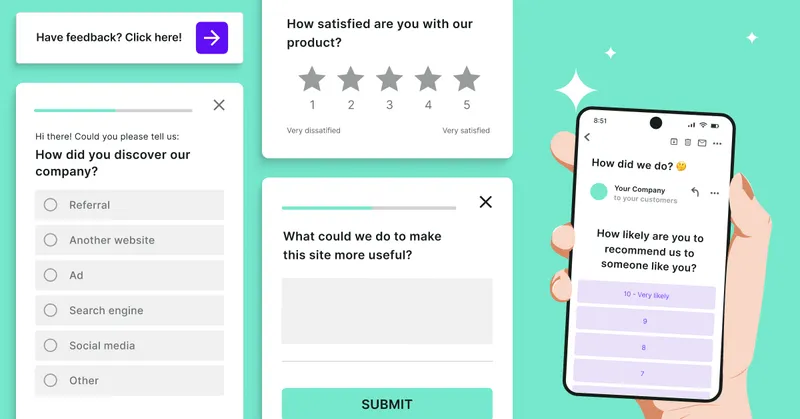Tl; dr;
- 360-degree feedback is multifaceted: It is a comprehensive review system involving various stakeholders, which provides a broad perspective on an employee's performance, as opposed to traditional reviews that typically involve only a manager's perspective.
- Diverse participant selection enriches feedback: Involving a range of reviewers from different work relationships with the employee ensures a wide variety of perspectives and a more complete picture of performance.
- Online employee surveys for feedback collection: Utilizing online platforms for feedback collection can simplify the process, making it more efficient and user-friendly for participants while also aiding in maintaining anonymity.
- Actionable insights drive development: Analyzing feedback to extract clear, actionable insights is key to using the process for personal and professional growth rather than just compiling opinions.
.webp)
Are you spinning in circles to get a clear picture of your performance? Straighten out with a 360-degree feedback guide.
This article sheds light on the complexities of 360-degree feedback – a method that captures insights from all angles. We'll dissect the problems of limited perspective in traditional reviews and hint at the multi-faceted solution that 360-degree feedback offers.
By the end of this read, you'll grasp the benefits of a comprehensive review system and be equipped to implement it effectively, setting the stage for enhanced performance and personal development.
What is 360-degree feedback?
360-degree feedback is an evaluation method that involves collecting multi-rater feedback for you from a comprehensive set of peers, subordinates, supervisors, and sometimes, from external sources like clients or customers.
This multi-rater approach ensures that you receive a holistic view of your strengths and areas for development.
- Peers and Colleagues: They provide insights into your teamwork and collaboration skills.
- Direct Reports: Their feedback can highlight your leadership and management effectiveness.
- Supervisors: They offer a strategic perspective on your alignment with organizational goals.
- Self-Assessment: You will also typically evaluate your own performance, which is instrumental for self-awareness.
This feedback system is unique because it includes multiple perspectives beyond traditional top-down managerial reviews.
Consequently, it helps paint a more accurate picture of your work performance and behavior. The process is often anonymous to encourage honest feedback.
When implemented properly, 360-degree feedback can be a powerful development tool. It's not just about identifying weaknesses; it's equally about recognizing your strengths and uisng them successfully.
The ultimate aim is to support your personal and professional growth within the organization's objectives.
What is the difference between 360-degree feedback and employee performance reviews?
360-degree feedback and traditional performance reviews serve distinct purposes in employee assessment.
Employee performance review typically involves a one-on-one evaluation between an employee and their direct manager, focusing on the individual's job performance over a specific period. This process often emphasizes goal achievement, job competencies, and areas for improvement from a singular perspective.
In contrast, 360-degree feedback incorporates a comprehensive view by collecting insights from various sources, including peer review.
The intent is to provide a well-rounded view of an employee's behavior, skills, and working relationships.
This type of feedback is less about evaluating job performance and more about professional and personal development. It encourages self-awareness by highlighting strengths and identifying potential areas for growth from multiple viewpoints.
While performance reviews are generally more formal and may be tied to compensation or promotion, 360-degree feedback is often used as a developmental tool to enhance organizational communication and teamwork.
How to design a 360-degree feedback process
Designing a 360-degree feedback process involves careful planning and clear communication. Here’s how to create an effective system:
1. Define objectives
Begin by setting clear goals for the feedback process. Determine what you aim to achieve, whether it’s improving communication, leadership skills, or team dynamics. Objectives should align with your organization's overall development strategy.
2. Choose participants
Select a diverse group of participants who will interact with the employee in various capacities. This should include managers, peers, direct reports, and sometimes customers.
Ensure the group is large enough to gather varied insights but not so large that the process becomes unmanageable.
3. Develop questionnaires
Create a questionnaire that reflects the competencies and behaviors relevant to the employee's role and your objectives. Questions should be clear, concise, and neutral to encourage honest and constructive feedback. A mix of rating scales and open-ended questions can provide quantitative and qualitative data.
4. Communicate the process
Communicate the purpose, process, and confidentiality of the feedback to all participants. This helps manage expectations and underscores the developmental nature of the exercise.
5. Administer the feedback
Decide on a method for collecting feedback. Depending on your resources, this could be through an online platform or paper forms. Ensure the process is easy to follow and accessible to all participants.
6. Analyze the results
Once feedback is collected, compile the data carefully. Look for patterns and key takeaways that align with the initial objectives. Prepare reports that are easy to understand and focus on actionable insights.
7. Provide support
Offer support to employees in interpreting their feedback. This might include one-on-one sessions with a manager or HR professional to discuss results and develop a plan.
8. Follow-up
Set up a system for employees to act on feedback and measure progress. This could involve setting specific goals, ongoing training, and scheduling follow-up assessments to track improvements.
Giving actionable feedback in the 360-degree process
Providing actionable feedback is crucial in the 360-degree review process. It should be specific, focused on behavior rather than personal traits, and include examples to clarify points. To ensure feedback is constructive, follow these steps:
Be specific and objective
Avoid vague comments. Instead, describe observable behaviors and their impact on the team or project. This helps the recipient understand exactly what actions must be taken to continue or change.
Balance positives and areas for improvement
Combine praise for strengths with suggestions for growth. This approach encourages motivation and acknowledges the value of the employee's contributions.
Offer clear examples
Illustrate your points with examples. This helps the receiver see real instances where they excelled or need to develop.
Suggest practical steps
End feedback with practical advice or steps the individual can take to improve. This might include training opportunities or setting measurable goals.
By following these guidelines, feedback becomes a tool for genuine development, fostering a culture of continuous improvement and collaboration.
.webp)
Benefits of 360-degree feedback
360-degree feedback is a comprehensive review process that offers you a multifaceted view of your performance through anonymous feedback from your work circle, including managers, peers, direct reports, and sometimes clients.
Enhanced self-awareness
In this feedback process, you receive insights about how others perceive your work, allowing you to understand your strengths and areas for improvement better.
This feedback can highlight discrepancies between how you view your performance and how others do, fostering greater self-awareness.
Team development
Your team gains from 360-degree feedback through better communication and understanding each other's strengths and weaknesses.
This can lead to stronger team cohesion and more targeted development efforts as team members work collaboratively to improve their skills.
Organizational impact
For your organization, the introduction of 360-degree feedback can lead to an improvement in overall performance. It promotes a culture of continuous feedback and development where employees feel valued and invested.
The feedback data can also inform strategic decisions around training needs and leadership development within the company.
Challenges and Considerations
When implementing 360-degree feedback, you face several key challenges that can impact the effectiveness of the process.
Managing subjectivity and bias
Understanding the influence of personal perspectives is essential since it is multi-rater feedback and involves a range of reviewers.
- Preparation: You must ensure that reviewers are adequately trained to provide objective feedback.
- Guidance: Clear guidelines should be provided to minimize the potential for personal biases to affect the evaluations.
Ensuring anonymous feedback
Anonymity is vital to encourage honest feedback, but it can be difficult to guarantee.
- Policy: Establish strict confidentiality policies to protect employee identities.
- Technology: Use secure systems that allow reviewers to submit anonymous feedback without fear of being identified.
Feedback interpretation challenges
Interpreting the feedback from multiple stakeholders accurately is challenging due to its qualitative and quantitative nature.
- Support: Offer access to development coaches or human resources personnel to help interpret the feedback.
- Action plan: Encourage the creation of a concrete action plan based on the feedback to provide clear direction for improvement.
Best practices in 360-degree feedback
The efficacy of a 360-degree feedback process relies on its structured implementation. Below, you will find the essential steps to ensure actionable feedback.
Setting clear objectives
You need to establish what you aim to achieve with 360-degree feedback. Goals should be specific, measurable, and aligned with your organization's strategy. When setting these objectives, consider the following:
- What competency areas are most crucial to your company's success?
- How will you measure improvement in these areas after the feedback is processed?
Effective communication strategies
Effective communication is paramount to guarantee a smooth 360-degree feedback process.
Before the launch:
- Clearly articulate the purpose and benefits of the 360-degree feedback to all participants.
- Instruction on how to provide constructive feedback is critical.
During the process:
- Maintain confidentiality to encourage honest and open responses.
- Offer support and resources, such as workshops or guidelines, to assist participants in understanding and engaging with the process.
Follow-up actions
Post-feedback follow-up is where the real growth occurs.
- Individual Development Plan (IDP): Work with feedback recipients to create IDPs that focus on key areas for development.
- Progress reviews: Schedule regular check-ins to discuss progress on the IDP and make any necessary adjustments.
Remember, feedback is a cycle, not a one-time event. Continuous improvement is facilitated through regular feedback loops and follow-up support.
Collect improved feedback with Survicate
The 360-degree feedback process is a valuable tool for personal and professional development, offering a comprehensive perspective on performance. The key to unlocking the full potential of this process lies in the effective collection, analysis, and action upon the feedback received.
Survicate survey software emerges as an ideal solution for building this process. With its user-friendly interface and customizable surveys, Survicate make it simple to gather insightful feedback from all relevant parties.
Its features support anonymity and ease of use, ensuring honest and constructive feedback. Moreover, the ability to analyze results with Survicate can help you spot trends and take actionable steps toward growth.
Embrace the opportunity to enhance self-awareness, encourage team development, and positively impact your organization.
Take the first step towards a more insightful feedback process by trying Survicate. Start your free 10-day trial today and explore all the Business Plan features to make the most of your 360-degree feedback initiatives.
360-degree feedback FAQs
In this section, you'll find key information on 360-degree feedback within performance appraisals, the nature of giving feedback, essential components of the feedback report, reasons for its controversy, and its impact on professional and personal development, along with its benefits and potential challenges for organizations.
How is 360-degree feedback used in performance appraisals?
360-degree feedback is implemented in performance appraisals by gathering evaluations of an employee's behavior, skills, and work output from various workplace participants, including supervisors, peers, subordinates, and sometimes clients, to provide a comprehensive perspective on the employee's performance.
What constitutes constructive 360-degree feedback?
Constructive 360-degree feedback is characterized by being specific, focused on behavior rather than personal characteristics, balanced with positive and developmental comments, and aimed at supporting the individual's professional growth and improvement.
What key components should be included in a 360-degree feedback report?
A well-rounded 360-degree feedback report should include quantifiable data, qualitative comments, summaries of strengths and areas for development, and actionable suggestions for performance improvement from the variety of respondents.
Why might 360-degree feedback be a contentious method of evaluation?
360-degree feedback can be contentious due to anonymity leading to uninhibited criticism, the potential for biased or unfounded comments, and the impact it can have on workplace relationships if not implemented with transparency and clear communication strategies.
How can 360-degree feedback contribute to an individual's professional development?
When effectively used, 360-degree feedback can reveal blind spots, reinforce strengths, encourage personal accountability, and outline clear paths for career advancement and skills enhancement, contributing to the individual's continuous professional development.
What are the potential benefits and drawbacks of implementing 360-degree feedback in an organization?
Implementing 360-degree feedback can improve self-awareness, promote a culture of open communication, and foster teamwork. However, it may also lead to discomfort, miscommunication, and resistance if not carefully managed and aligned with the organization's values and performance goals.










.webp)





